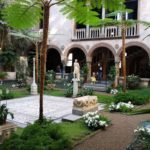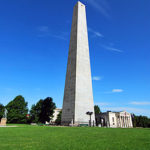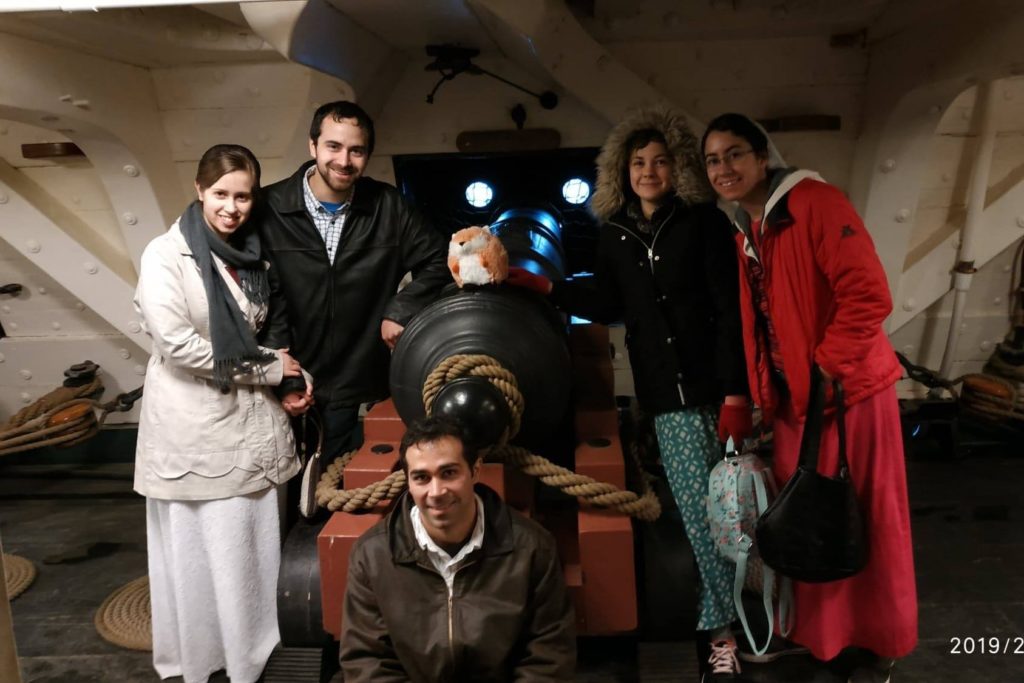I am home. I sit in the library in Ladysmith, Wisconsin, looking out the window at the snow and melting ice. Home is good. My brothers picked me up from the airport, and the minute we entered Rusk County, I felt the silence of the place—silence laid out like carpet, swathed in snow and sky. In Boston, I never hear the noise. It is only when I am here in Rusk County I realize how noisy the city must be.
My last six weeks have been noisy as well—busy with academics, work, friendships, with monumental affairs of the heart and the spirit. Home is a good place to relax and regroup.
Of everything I’ve been doing and thinking the past month and a half, I recommend:
Apologetics Videos
I’ve always loved Christian apologetics. Books like The Case for a Creator by Lee Strobel and Seeking Allah, Finding Jesus by Nabeel Qureshi have bolstered my faith during times I questioned its legitimacy. In our age of science, many of us wonder if our faith makes sense historically and scientifically and feel the need to build a strong foundation of thought in those areas. In Apologetics class at Sattler College, I get the chance to do exactly that. Here are some of the videos we’ve sourced.
The Moral Argument: Why should you believe there is a God? A five-minute presentation of the moral argument by Reasonable Faith.
Fine Tuning: The fine tuning of the universe presents a powerful argument for the existence of a designer. A five-minute presentation by Reasonable Faith.
7 Days that Divide the World: For those of us who have been raised to believe in a 6,000-year-old-world, this lecture by John Lennox is worth watching to understand the perspective of Christians who believe in both the Bible and an old earth. Also worth watching just to hear Mr. Lennox’s cool British accent and the hilarious pre-lecture commentary of Eric Metaxas.
What Are the Limits of Darwinism?: Michael Behe, author of Darwin’s Black Box: The Biochemical Challenge to Evolution, presents a powerful argument for design.
The Meaning of Life: Humans understand best through story, and Ravi Zacharias is a master of the art. This talk is not so much a defense of faith as a holistic discussion of the fullness of life which faith brings.
Books
Lies Women Believe And the Truth that Sets Them Free: This book, by Nancy DeMoss Wolgemuth, explores 45 lies women believe. In her words: “From that first encounter in the garden to the present day, Satan has used deception to win our affections, influence our choices, and destroy our lives. In one way or another, every problem we have in this world is the fruit of deception—the result of believing something that simply isn’t true.” In Lies Women Believe, Ms. Wolgemuth sets out to replace some of the most common lies with a foundation of truth. You can choose to buy this with a study guide, which makes it a great choice for a woman’s Bible study.
This book, by Nancy DeMoss Wolgemuth, explores 45 lies women believe. In her words: “From that first encounter in the garden to the present day, Satan has used deception to win our affections, influence our choices, and destroy our lives. In one way or another, every problem we have in this world is the fruit of deception—the result of believing something that simply isn’t true.” In Lies Women Believe, Ms. Wolgemuth sets out to replace some of the most common lies with a foundation of truth. You can choose to buy this with a study guide, which makes it a great choice for a woman’s Bible study.

Antigone: By Sophocles. Of all the ancient Greek literature we’ve read this semester, Antigone is my favorite. Key to understanding the story is understanding the importance of a proper burial in ancient Greece and the primacy of law in Athenian democracy. What happens when a young woman breaks the kings’s law for what she believes to be a higher Law? An interesting exploration of civil disobedience, but read it only if you enjoy Shakespearean-type drama.This is the final play in a three-part series; read Oedipus Rex and Oedipus at Colonus first to get the full scope of the story.
 The History of the Peloponnesian War: By Thucydides. In a time when myth mixed with history, Thucydides claimed that his history was based strictly on his own experience and eyewitness accounts which he went to great efforts to verify. “I have written my work, not as an essay which is to win the applause of the moment,” he tells us, “but as a possession for all time.” Thucydides’ careful work paid off; his book is required reading today for members of the U.S. military. I am not normally a lover of pure, dry history, but I was fascinated by this book for two reasons. 1. I know little of the Peloponnesian War and had no idea how the drama would play out. 2. It was fascinating to read about ancient politics and find them so eerily similar to politics today. But in ancient politics, I got to see the entire story unfold from a distance, watching each hard-fought decision lead to its inevitable—though often unexpected—outcome.
The History of the Peloponnesian War: By Thucydides. In a time when myth mixed with history, Thucydides claimed that his history was based strictly on his own experience and eyewitness accounts which he went to great efforts to verify. “I have written my work, not as an essay which is to win the applause of the moment,” he tells us, “but as a possession for all time.” Thucydides’ careful work paid off; his book is required reading today for members of the U.S. military. I am not normally a lover of pure, dry history, but I was fascinated by this book for two reasons. 1. I know little of the Peloponnesian War and had no idea how the drama would play out. 2. It was fascinating to read about ancient politics and find them so eerily similar to politics today. But in ancient politics, I got to see the entire story unfold from a distance, watching each hard-fought decision lead to its inevitable—though often unexpected—outcome.
Boston Sights
I’ve been blessed with visits from family and friends in the past few months, and for that reason, have had a number of chances to explore Boston. I’ve listed a few of my favorite places below. If you ever visit Boston (I’m here attending college, hint, hint), you might enjoy them, too.

The Printing Press at Faneuil Hall: Faneuil Hall has been a marketplace and meeting hall since 1743 and was the site of speeches by Samuel Adams, James Otis, and other rabble rousers. My favorite stop is the printing press, where you can watch the Declaration of Independence printed in almost exactly the same way it would have been in 1776. I learned that our terms “lowercase” and “uppercase” originated from where the pieces of type were stored in those days: in a case with the capital letters in the upper compartment and lowercase letters in the lower.

Isabella Stewart Gardner Museum: The unconventional and stylish Mrs. Gardner collected art throughout her life and housed it in a Renaissance-inspired mansion in the Fenway area of Boston. Her eclectic collection has stood for a hundred years exactly as she left it, and when the museum was robbed of several prime pieces in 1990, the empty spaces on the wall were left untouched.

Regina Pizzeria: We waited thirty minutes just to get inside the building—but the pizza was worth every minute. It was rated third best in the world on TripAdvisor, and the door is covered with awards.
 Bunker Hill Monument: My siblings and I sang as we climbed the 294 steps of the Bunker Hill Monument, just to hear the sound echo against the quarried granite walls. From the top, we had a bird’s eye view of Boston.
Bunker Hill Monument: My siblings and I sang as we climbed the 294 steps of the Bunker Hill Monument, just to hear the sound echo against the quarried granite walls. From the top, we had a bird’s eye view of Boston.
 U.S.S. Constitution: I toured the U.S.S. Constitution, the oldest commissioned ship in the U.S. Navy, twice. Each time I learned new and interesting facts about the life of sailors in the early 1800’s and heard a blow-by-blow account of the battle that earned this ship, with its sides made of solid Georgia oak, the nickname “Old Ironsides.” The tour, conducted by a member of the U.S. Navy, is free. Be sure to take your ID along—you will have to go through security before you’re allowed on ship.
U.S.S. Constitution: I toured the U.S.S. Constitution, the oldest commissioned ship in the U.S. Navy, twice. Each time I learned new and interesting facts about the life of sailors in the early 1800’s and heard a blow-by-blow account of the battle that earned this ship, with its sides made of solid Georgia oak, the nickname “Old Ironsides.” The tour, conducted by a member of the U.S. Navy, is free. Be sure to take your ID along—you will have to go through security before you’re allowed on ship.
Charley of the Month: The feature photo above was taken aboard the U.S.S. Constitution. That’s my brother Chad and his girlfriend Sharla standing on the left, my niece MacKenzie and sister Elizabeth standing on the right, and my brother Jeff kneeling in front. Charley, overjoyed to have so many travel buddies, is perched atop the cannon.

Ramona wanted to take us to that Isabella Stewart Museum but we ran out of time. Have you been to the Harvard Museum yet? The glass blown flowers room is so so amazing…it was the best museum on the whole that I have ever been in I think.